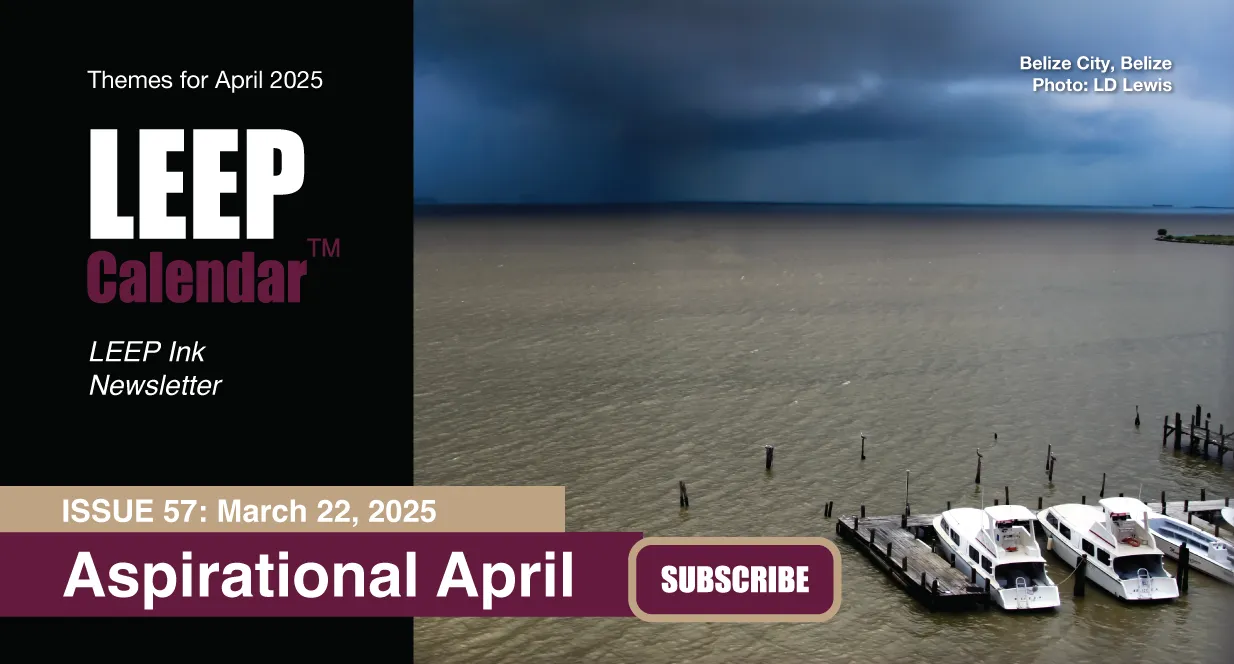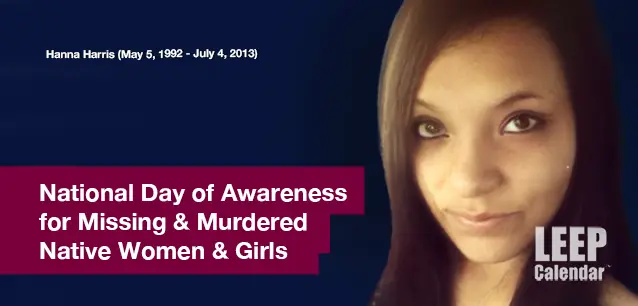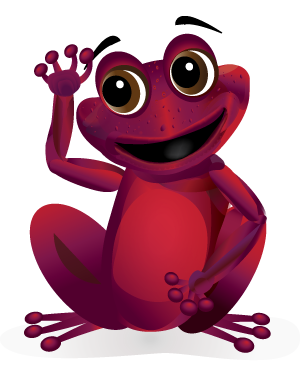 AD
AD
Today is: July 13
Scroll to explore events active on this date.
LEEP INK FEATURES

May Blooms: Events in May 2025
Along with October, May is one of the most densely packed months of the year. It's before the summer humidity and the last whole month of the school year. The weather is warming in t...

Sweet June 2025
The solstice on the 20th marks the onset of summer (Northern Hemisphere) or winter (Southern Hemisphere). Many people, particularly in Europe, North America and Asia, will be embarking o...

Events in April 2025
Spring has sprung in the north, and the first hints of Autumn are on the horizon in the south. April is the month spring (or fall) gets underway, and it is filled with religious celebrations, including the Mu...
About National Day of Awareness for Missing and Murdered Native Women and Girls
Women , Safety & Security
Culture & Art , United States
Ends: May 05, 2024
DESCRIPTION:
National Day of Awareness for Missing and Murdered Native Women and Girls Honors Victims and Calls for Action
National Day of Awareness for Missing and Murdered Native Women and Girls acknowledges and raises awareness about the disproportionate rates of violence faced by Native American and Alaska Native women and girls. Activists, families, and community leaders come together to remember the victims and advocate for systemic changes to address this ongoing crisis.
It originates from the tragedy of Hanna Harris (May 5, 1992 - July 4, 2013). Her case brought attention to the epidemic of violence against Indigenous women and sparked national advocacy efforts. In response to widespread calls for justice, the US Congress officially designated May 5 as the National Day of Awareness for Missing and Murdered Native Women and Girls in 2017.STATISTICS ILLUSTRATE A GRIM REALITY
Native American women face murder rates that are more than ten times the national average, and they are significantly more likely to experience violence in their lifetimes.
Statistics on crimes against Native American women reveal deeply troubling issues, including high rates of rape, murder, assault, harassment, racism, and domestic violence. Here is the most recent data (as of April 2024) publicly available:
Violence Rates:
According to the National Institute of Justice, more than four in five American Indian and Alaska Native women (over 84%) have experienced violence in their lifetimes. These statistics include 56% who have experienced sexual violence and 55% who have experienced physical violence by an intimate partner.
Sexual Violence:
Native American women face murder rates that are more than ten times the national average in some counties, primarily those that are rural and on reservations. Sexual assault rates among Native American women are also exceptionally high, with studies suggesting that one in three Native American women report rape during their lifetime.
Missing and Murdered Indigenous Women (MMIW):
The issue of MMIW (Missing and Murdered Indigenous Women) is a critical concern. Data collection is inconsistent and often underreported, but it's clear that indigenous women are murdered at a rate much higher than national averages. For instance, in some regions, the rate of fatal assault against Native American women is more than double that of the US average.
Domestic Violence:
Domestic violence is a significant issue, with more than half of Native American women experiencing intimate partner violence in their lifetime. This rate is significantly higher than that for white, black, or Hispanic women.
Racism and Harassment:
Racism and systemic discrimination exacerbate the risks faced by Native American women. Racially motivated harassment and violence are prevalent concerns, often complicating the legal and social services landscape that victims must navigate.
Challenges in the Legal System:
The legal framework presents unique challenges for prosecuting crimes on tribal lands due to jurisdictional complexities between federal, state, and tribal authorities, often leading to lower prosecution rates of violent crimes against Native American women.
Data and Reporting Issues:
There is a significant issue with the underreporting and misclassification of violent crimes against Native American women. Many cases go unreported, and data collection methods are inconsistent, which hampers accurate statistical analysis and the effective targeting of resources and support.
Efforts are ongoing to improve data collection, legal jurisdictional clarity, and resource allocation to address these severe issues effectively. The Violence Against Women Act (VAWA) reauthorization and other legislative measures are steps toward addressing the systemic nature of these crimes.
National Day of Awareness for Missing and Murdered Native Women and Girls coincides with broader efforts, such as the movement for a national inquiry into these issues and implementing more robust databases to track such crimes. Advocates continue to push for the passage of more comprehensive legislation like Savanna's Act and the Not Invisible Act, which aim to address jurisdictional challenges and improve coordination among federal agencies.
CONTEXT AND BACKGROUNDWHAT IS AN INDIGENOUS PERSON?
The definition of an "indigenous person" involves several key characteristics distinguishing them from other population segments within a country or region. The term is broadly used to describe the original inhabitants of a territory who have maintained a cultural identity distinct from the dominant society now governing that territory. Defining characteristics include:
HISTORICAL CONTINUITY
Indigenous peoples are descendants of the original inhabitants of a region or country who lived there before colonizing or settling populations arrived. Thus, they have historical continuity.
CULTURAL DISTINCTION
Indigenous peoples maintain cultural, social, economic, and political characteristics distinct from those of the dominant society. These include language, traditional practices, social structures, and often spirituality linked to their ancestral lands.
SELF-IDENTIFICATION
Self-identification as indigenous or belonging to an indigenous group is an integral part of their community membership and is often a requirement for legal and social recognition.
CONNECTION TO THE LAND
Indigenous peoples' traditional practices, livelihoods, and cultural and spiritual lives are often closely connected to their home region's land, water, and natural resources.
GROUP CONSCIOUSNESS
First Nations people possess a strong sense of group identity, expressed through a common heritage, language, history, and connection to the land. Often, this consciousness emerges as an opposition to the dominant society's policies and practices that seek to assimilate them or undermine their rights.
HISTORICAL DISADVANTAGE
Native peoples are frequently marginalized, disenfranchised, and disadvantaged by post-colonial and settler governments that have sought to erase their cultures and usurp their lands, including reducing access to political power and economic resources.INTERNATIONAL RECOGNITION
International bodies, including the United Nations, have frameworks to protect the rights of indigenous peoples. The UN's definition, guided by the work of José Martínez Cobo (Special Rapporteur on Discrimination against Indigenous Populations), emphasizes non-dominance, cultural difference, and self-identification. Key documents include the United Nations Declaration on the Rights of Indigenous Peoples (UNDRIP), which outlines and protects Indigenous peoples' rights to land, culture, education, and health care, free from discrimination.
Internationally, the best-known indigenous groups include:
AUSTRALIA
Aboriginal Australians–Indigenous peoples of the Australian mainland and Tasmania.
Torres Strait Islanders–Indigenous people of the Torres Strait Islands, part of Queensland.
PALESTINE/ISRAEL
Palestinians—The indigenous population of Arab descent in the regions historically and currently known as Palestine, including Jewish, Christian, Muslim, and other faiths.
ZIMBABWE
Shona–The largest ethnic group in Zimbabwe, making up more than 70% of the population.
Ndebele–The second largest ethnic group in Zimbabwe, predominantly in the country's south.
MEXICO
Nahuas–Indigenous people are famously known as Aztecs; they speak Nahuatl and live mainly in central Mexico.
Mayas–Indigenous people known for their historical civilization, residing primarily in the Yucatán Peninsula.
Zapotecs–Indigenous people originally from the Oaxaca region.
Mixtecs–are native to the region known as La Mixteca, which covers parts of Oaxaca, Guerrero, and Puebla.
SOUTH AFRICA
Zulu–One of the significant Bantu groups in South Africa, primarily in KwaZulu-Natal.
Xhosa–Another major Bantu ethnic group living predominantly in the Eastern Cape and Western Cape.
San (Bushmen)–Indigenous hunter-gatherers traditionally live in the Kalahari Desert.
Khoikhoi (Khoi)–Pastoralist people from the Cape region.
GABÓN
Fang –The largest ethnic group, also found in neighboring countries such as Cameroon.
Punu–One of the several Bantu peoples of Gabon.
Obamba–is an indigenous group in the central part of Gabon.
NEW ZEALAND
Māori–The indigenous Polynesian people of New Zealand, originally from Polynesian islands.
BRAZIL
Brazil is home to a diverse array of indigenous tribes, including:
Guarani: The Guarani are one of the most populous tribes in South America, especially prominent in the southern part of Brazil. They are known for their spiritual beliefs and agricultural practices.
Kayapo: The Kayapo are known for their intricate body paint and headdresses. They reside in the Brazilian Amazon and are very active in environmental and political issues concerning the Amazon rainforest.
Yanomami: This tribe lives in the northern Amazon region along the border between Brazil and Venezuela. The Yanomami have received international attention due to their struggles with illegal mining operations and deforestation.
Tikuna: The Tikuna tribe is the largest indigenous group in the Brazilian Amazon, with a population spanning Brazil, Peru, and Colombia. They are known for their traditional ceremonies and crafts.NATIVE AMERICANS VS FIRST NATIONS PEOPLE
In the United States, there are currently 574 federally recognized Native American tribes. This count includes both Native American tribes and Alaska Native villages, which are recognized as sovereign entities by the US federal government and are thus entitled to self-government. In Canada, the indigenous people, referred to as First Nations, are represented in 630 distinct populations. Below are the top five groups for each country.
FIVE LARGEST NATIVE AMERICAN TRIBES
Here are the five largest tribes by enrollment figures, along with their primary locations:
NAVAJO NATION
Location: Extends into Arizona, Utah, and New Mexico.
Enrollment: +/- 300,000 members.
The Navajo Nation is the largest and one of the most politically influential Native American tribes in the United States. They have the largest reservation, which spans over 17 million acres.
CHEROKEE NATION
Location: Primarily based in Oklahoma.
Enrollment: +/- 200,000 members.
The Cherokee Nation is one of the three federally recognized tribes with the most tribal citizens.
CHOCTAW NATION
Location: Primarily based in Oklahoma.
Enrollment: +/- 200,000 members.
The Choctaw Nation is another of the major tribes in Oklahoma, originally from the Southeastern United States.
SIOUX
Location: The Sioux are divided into groups with populations spread across several states, including South Dakota, North Dakota, Minnesota, and Nebraska.
Enrollment: The Sioux consists of three major divisions (Dakota, Lakota, and Nakota), and enrollment numbers vary; the Sioux have +/- 170,000 members across various subgroups.
The Sioux tribes include several bands and are known for their historical and cultural heritage.
CHIPPEWA (OJIBWE)
Location: Primarily located in the Northern Midwest USA and parts of Canada, including Michigan, Wisconsin, Minnesota, and North Dakota.
Enrollment: +/- 170,000 members.
The Chippewa, also known as Ojibwe, have several bands that live across a wide area in the United States and Canada.
These tribes are significant because of their large populations and cultural, economic, and political influence in their regions and across the country. Each tribe has its government, laws, police, and services, just like a small country.CANADA'S FIVE LARGEST FIRST NATIONS
In Canada, the term "tribes" is not used; instead, the terms First Nations, Inuit, and Métis are standard.
More than 630 First Nations governments or bands are spread across Canada, encompassing various cultures, languages, and histories. These First Nations are part of the broader distinctions of Indigenous peoples in Canada, including the Inuit of the Arctic and the Métis people, who trace their descent to Indigenous North Americans and European settlers.
Here are the five largest First Nations by population, along with their primary locations:
SIX NATIONS OF THE GRAND RIVER
Location: Ontario
Population: +/- 27,000 members.
The Six Nations of the Grand River is the largest First Nation in Canada regarding the population registered under the Indian Act. Initially, this designation covered the Mohawk, Cayuga, Onondaga, Oneida, Seneca, and Tuscarora nations.
MOHAWKS OF AKWESASNE
Location: Ontario, Quebec, and part of New York (USA)
Population: +/- 12,300 members.
Akwesasne straddles the borders of Quebec, Ontario, and New York State on the St. Lawrence River. It is unique due to its location across two countries and three jurisdictions.
SQUAMISH NATION
Location: British Columbia
Population: 10,000+ members.
The Squamish Nation lives in the Greater Vancouver Area, including the scenic lands surrounding Howe Sound and the northern part of Vancouver.
TSLEIL-WAUTUTH NATION
Location: British Columbia
Population: +/- 5,000 members.
The Tsleil-Waututh Nation, also known as the "People of the Inlet," is located on the shores of Burrard Inlet in North Vancouver, British Columbia.
LA LA RONGE INDIAN BAND
Location: Saskatchewan
Population: +/- 11,000 members.
The largest First Nation in Saskatchewan and one of the ten largest in Canada, the Lac La Ronge embodies six northern communities.
These First Nations are crucial to understanding the social, cultural, and political landscape of Indigenous peoples in Canada. Each First Nation governs itself according to its governance systems under the frameworks established by the Canadian government and treaties.
CONCLUSION
Worldwide, First Nations, native peoples, and the original inhabitants of their lands continue to fight for their rights, culture and beliefs, whether self-determination or equal treatment under the law. However, in areas of law enforcement and protection, being an Indigenous person often leads to more crime and less justice, whether in the United States, the Amazon, Yukon or Palestine.
National Day of Awareness for Missing and Murdered Native Women and Girls is an American awareness campaign designed to focus on increasing safeguards, resources and the reporting of crimes against Native American women and girls in the United States. The day, though, resonates with all indigenous people the world over.
Regardless of borders, they tend to be targeted for crime and abuse at a much higher rate than the population at large. Today is a day to highlight their struggle, wherever they are, on this great blue marble we call home.
VIDEOS
SUPPORTING DOCUMENTS
Currently, this event does not have supporting documents.
ADDITIONAL IMAGES
Currently, this event does not have supporting images.
Where would you like to go now?
 AD
AD


/footer-logo.svg)
